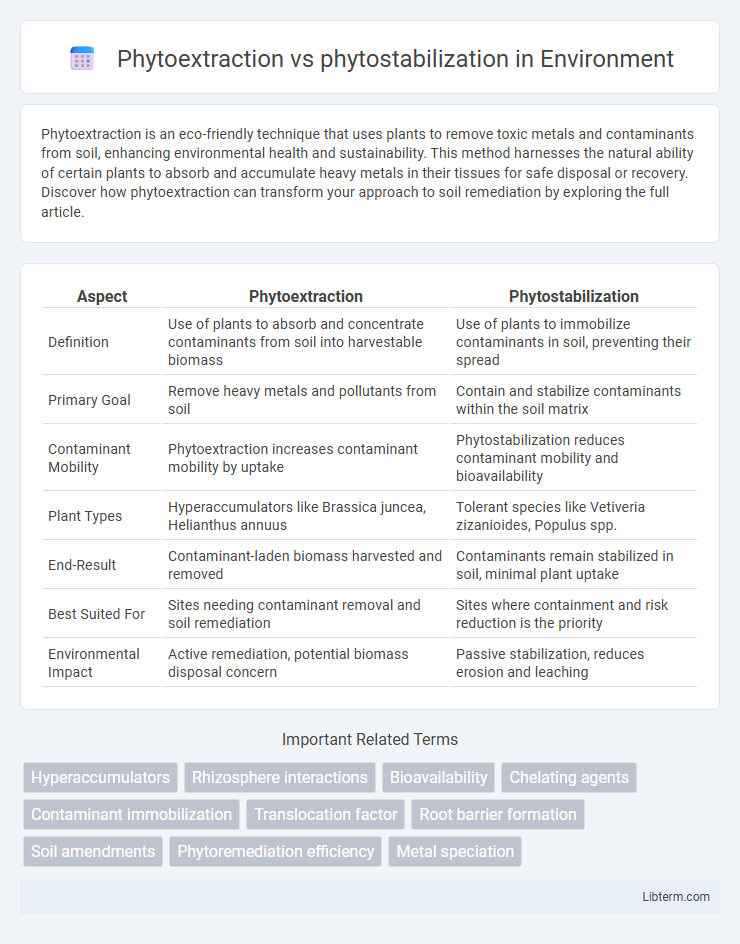Phytoextraction is an eco-friendly technique that uses plants to remove toxic metals and contaminants from soil, enhancing environmental health and sustainability. This method harnesses the natural ability of certain plants to absorb and accumulate heavy metals in their tissues for safe disposal or recovery. Discover how phytoextraction can transform your approach to soil remediation by exploring the full article.
Table of Comparison
| Aspect | Phytoextraction | Phytostabilization |
|---|---|---|
| Definition | Use of plants to absorb and concentrate contaminants from soil into harvestable biomass | Use of plants to immobilize contaminants in soil, preventing their spread |
| Primary Goal | Remove heavy metals and pollutants from soil | Contain and stabilize contaminants within the soil matrix |
| Contaminant Mobility | Phytoextraction increases contaminant mobility by uptake | Phytostabilization reduces contaminant mobility and bioavailability |
| Plant Types | Hyperaccumulators like Brassica juncea, Helianthus annuus | Tolerant species like Vetiveria zizanioides, Populus spp. |
| End-Result | Contaminant-laden biomass harvested and removed | Contaminants remain stabilized in soil, minimal plant uptake |
| Best Suited For | Sites needing contaminant removal and soil remediation | Sites where containment and risk reduction is the priority |
| Environmental Impact | Active remediation, potential biomass disposal concern | Passive stabilization, reduces erosion and leaching |
Introduction to Phytoremediation
Phytoextraction and phytostabilization are two primary techniques within phytoremediation, a green technology that utilizes plants to clean contaminated soils. Phytoextraction involves the uptake of heavy metals or pollutants by plant roots and translocation to above-ground tissues for harvest and removal. In contrast, phytostabilization focuses on immobilizing contaminants in the soil through root absorption and precipitation, reducing their bioavailability and preventing environmental spread.
Defining Phytoextraction
Phytoextraction is a phytoremediation process where plants absorb contaminants, such as heavy metals, from soil or water, concentrating them in harvestable biomass for removal. This technique targets the extraction and recovery of pollutants through root uptake followed by translocation to above-ground parts, which can be harvested and disposed of or recycled. Unlike phytostabilization, which immobilizes contaminants in the root zone to prevent spread, phytoextraction actively decreases pollutant levels in the environment by removing them entirely.
Defining Phytostabilization
Phytostabilization refers to the use of plants to immobilize contaminants in soil, preventing their migration and reducing bioavailability, primarily through root absorption and sorption. Unlike phytoextraction, which involves the uptake and removal of pollutants by plants, phytostabilization stabilizes contaminants in situ, minimizing environmental risks such as leaching or erosion. This method is commonly applied for heavy metals and radionuclides in polluted sites where removal is impractical or unsafe.
Mechanisms Involved in Phytoextraction
Phytoextraction involves hyperaccumulator plants absorbing heavy metals or pollutants from soil into their roots and translocating them to above-ground tissues through active uptake and translocation mechanisms. This process relies on metal transporters, chelating agents, and enhanced root-to-shoot translocation, enabling efficient metal accumulation in harvestable biomass. In contrast, phytostabilization immobilizes contaminants in the rhizosphere, reducing bioavailability without removing pollutants from the site.
Mechanisms Involved in Phytostabilization
Phytostabilization involves immobilizing contaminants in the soil through root absorption, precipitation, and adsorption processes, reducing their bioavailability and preventing leaching or spread to groundwater. This mechanism relies on root exudates altering the chemical form of pollutants, facilitating their immobilization within the rhizosphere. Unlike phytoextraction, which actively removes contaminants through plant uptake and harvest, phytostabilization primarily focuses on stabilizing and containing pollutants in situ.
Key Differences Between Phytoextraction and Phytostabilization
Phytoextraction involves the uptake and accumulation of contaminants, primarily heavy metals, from soil into plant biomass for subsequent harvest and removal, whereas phytostabilization immobilizes pollutants in the soil by reducing their bioavailability through root absorption, precipitation, or adsorption. Phytoextraction targets contaminant removal, making it suitable for highly polluted soils, while phytostabilization focuses on preventing contaminant migration and exposure, ideal for stabilizing moderately contaminated sites. The choice between methods depends on contaminant type, soil characteristics, and remediation goals.
Factors Affecting Efficiency of Both Techniques
Soil pH, plant species selection, and contaminant bioavailability significantly influence the efficiency of phytoextraction and phytostabilization techniques. Phytoextraction efficiency depends heavily on plant uptake capacity and translocation of heavy metals to harvestable biomass, while phytostabilization relies on root zone microbial activity, soil amendments, and root exudates to immobilize pollutants. Environmental conditions such as temperature, soil moisture, and nutrient availability further impact the overall remediation performance of both strategies.
Common Plants Used in Each Method
Phytoextraction commonly involves plants like Indian mustard (Brassica juncea), sunflower (Helianthus annuus), and alpine pennycress (Thlaspi caerulescens) known for their ability to hyperaccumulate heavy metals such as lead, cadmium, and zinc. Phytostabilization utilizes species including vetiver grass (Chrysopogon zizanioides), Indian grass (Sorghastrum nutans), and poplar trees (Populus spp.) which immobilize contaminants in soil through root absorption and adsorption. Selection of plant species depends on metal tolerance, root structure, and growth rate to effectively remediate contaminated sites using each phytoremediation strategy.
Environmental and Economic Impacts
Phytoextraction actively removes heavy metals from contaminated soils through hyperaccumulator plants, reducing long-term environmental risks but often requiring extended time frames and higher costs for biomass disposal. Phytostabilization immobilizes contaminants in place, preventing their spread and reducing soil erosion while offering lower immediate costs and faster site stabilization, yet it leaves toxic elements in the soil, necessitating ongoing monitoring. Economically, phytoextraction can enable the recovery of valuable metals, creating potential revenue streams, whereas phytostabilization primarily serves as a cost-effective containment strategy with limited resource recovery.
Choosing the Right Strategy: Phytoextraction vs Phytostabilization
Phytoextraction is ideal for removing heavy metals from contaminated soils by accumulating them in harvestable plant biomass, making it suitable for sites where complete contaminant removal is desired. Phytostabilization stabilizes contaminants in the soil, preventing their migration and reducing bioavailability, which is effective for areas with diffuse pollution or where removal is impractical. Selecting between phytoextraction and phytostabilization depends on factors such as contaminant type, concentration, site conditions, and remediation goals.
Phytoextraction Infographic

 libterm.com
libterm.com